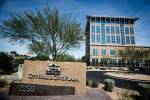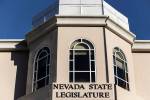More than TV ads needed to fight margins tax battle
CARSON CITY — One of the most expensive ballot fights in Nevada history is in full swing this month as groups vie for the hearts and minds, but most importantly the votes, of Nevadans over a measure that would impose a tax on business to fund public education.
But the fate of Question 3, or The Education Initiative, as it is called by its teacher-backed supporters, might not be determined by spending on television ads alone.
Nevada voters have a history of making up their own minds on important election questions, irrespective of the amount of dollars invested to produce the desired result.
Question 3 would raise an estimated $700 million a year for public education by imposing a 2 percent tax on the gross revenue of businesses exceeding $1 million a year.
In reports filed last week, the Coalition to Defeat the Margin Tax Initiative had raised over $4 million for the fight since the beginning of the year, with $3.3 million spent so far. Most has been put into television, and another big TV buy is underway.
The list of opponents also shows how hated the measure is by the business community. From the Nevada Resort Association and the Las Vegas Metro Chamber of Commerce to Sunrise Hospital and Medical Center and Nevada Power, businesses are stepping to the plate in the effort to defeat the tax.
Supporters, funded almost entirely by the Nevada State Education Association, have generated nearly $900,000 and spent more than $1.5 million.
MONEY JUST PART OF EQUATION
But money isn’t everything in a ballot fight in Nevada.
In 2006, voters were asked to pick between two ostensibly similar measures seeking to restrict smoking in public places. But Question 4, the weaker of the two measures that was backed by businesses that would be affected by such restrictions, lost despite seeing greater spending.
Supporters of Question 5, the more restrictive measure, had about $600,000 to spend on the effort. Supporters of Question 4 raised nearly $3 million.
In another heavily funded battle in 2004 over medical malpractice reform, voters faced three questions. One supported by lawmakers and physicians sought to limit awards while competing measures were placed on the ballot by trial lawyers.
The physician-backed measure, Question 3, was approved while the trial lawyers’ measures were defeated. This fight remains the most expensive ballot fight in Nevada history, with nearly $6 million spent by doctors and insurance companies for Question 3, and trial lawyers spending nearly $1 million on their measures.
David Damore, an associate professor of political science at the University of Nevada, Las Vegas, said he believes the pro-Question 3 side is at a disadvantage in the margins tax battle for voters in this year’s election.
“The gut reaction is to vote no,” he said. “So usually in these types of races involving tax increases the status quo side is less active.”
The situation is different with Question 3 in this election in that opponents are significantly outspending supporters, Damore said.
It might be that opponents are concerned about the number of undecided voters on the issue, or that the view espoused by teachers — that lawmakers have not shown any leadership and something needs to be done — is resonating with the electorate, he said.
A recent poll commissioned by the Las Vegas Review-Journal showed the measure losing 40-37, but more than one-fifth of voters, or 23 percent, were undecided in the survey taken Sept. 29 to Oct. 1.
Supporters need to convince potentially skeptical voters that any new tax money will be spent wisely to improve student performance, Damore said.
An issue for opponents that does appear to have traction is that there is no guarantee that funding for public education will increase, since the Legislature can reallocate existing public education funding to other needs, he said.
“Undecided voters will likely make their decision at the last minute,” Damore said. “Opponents are probably wondering what it will take to move them into the ‘no’ category.”
Turnout will be the key for backers of the measure, he said.
Michael Hackett of Reno-based Alrus Consulting, who worked on both the malpractice reform and smoking ban measures in the 2004 and 2006 elections, said the margins tax measure has become a real race.
“One of the key considerations is what the voter turnout is going to be,” he said. “If turnout is low, and I’m hearing 50 percent to 60 percent statewide, anything can happen.”
But it does appear that the anti-tax side, by putting out ads using Danny Thompson of the Nevada State AFL-CIO to sway voters against the measure, is getting antsy, Hackett said.
“My gut feeling is that they are getting concerned,” he said.
The decision by Tesla to build a battery plant in Northern Nevada might have given supporters of the measure some momentum, Hackett said.
“The Tesla discussion has drawn a lot of attention to education, on the lack of capital improvements and the number of teachers we need,” he said.
EDUCATION: PERSONAL FOR SOME
Dan Hart, a political consultant working to win support of Question 3, said money won’t be the deciding factor in whether voters support the measure at the ballot box.
“This is a very personal thing to a lot of people,” he said. “It’s not so much about TV commercials with CEOs. It’s a personal decision about the community, their kids and the kids that will come in the future.”
Several polls, including one generated by opponents to the tax, show it winning, Hart said. The anti-Question 3 sponsored poll conducted by Peter Hart in August showed it winning 53 percent to 42 percent with a margin of error of 3 points.
If many in the business community are concerned that the Legislature could reduce existing financial support to the public schools if the measure passes, then they should be asking lawmakers to commit to establishing the current funding to K-12 as a base, Hart said. With that commitment, then the new revenue from the margins tax would clearly supplement public education funding, he said.
Gov. Brian Sandoval is opposed to the measure because of the potential effect on the economy. In an interview last week he said he has had personal conversations both with new companies considering relocating and existing business owners who are waiting to see the result Nov. 4.
This despite the Tesla announcement and other positive developments, including the decision announced last week of a pharmaceutical fulfillment company expanding to Las Vegas next year with 353 jobs.
“It’s the stories you don’t hear, which are the businesses that aren’t coming or standing on the sidelines until they are aware of the outcome on the vote on Question 3,” Sandoval said. “There are as many or more that aren’t coming or are waiting.”
COULD HURT SMALL BUSINESSES, TOO
The margins tax would affect 13 percent of the state’s businesses, but it isn’t only large companies that would pay.
Just ask Monty Abrams of Las Vegas, who owns Gaging.com LLC, a one-person, home-based company with three independent representatives. The company does about $1.7 million a year in sales with expenses of $1.6 million, leaving him $100,000 a year. The company sells precision measuring tools.
If Question 3, or as he calls it, “this ridiculous proposal” passes, Abrams said it will cost him $34,000 and drastically reduce his income.
Abrams said he will be forced to take some action, such as incorporating in Delaware or selling his business and working as a consultant, if Question 3 is approved.
“I support more funding for education, but all Nevadans should bear the brunt of the expense,” he said. “If this passes, I’m going to lose $20,000 or $30,000 of my income but my neighbor won’t.
“How can a tax be based on revenue instead of profit?” Abrams asked.
Contact Capital Bureau reporter Sean Whaley at swhaley@reviewjournal.com or 775-687-3900. Find him on Twitter: @seanw801.






























